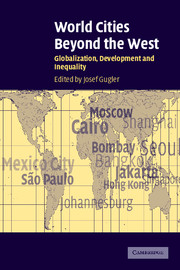Book contents
- Frontmatter
- Contents
- List of figures
- List of maps
- List of tables
- List of contributors
- Acknowledgments
- World cities beyond the West
- Introduction
- Part 1 The impact of the global political economy
- Part 2 The impact of the state
- Part 3 The impact of popular movements
- 10 São Paulo: the political and socioeconomic transformations wrought by the New Labor Movement in the city and beyond
- 11 Bombay/Mumbai: globalization, inequalities, and politics
- 12 Johannesburg: race, inequality, and urbanization
- Afterword
- Index
- References
11 - Bombay/Mumbai: globalization, inequalities, and politics
Published online by Cambridge University Press: 12 October 2009
- Frontmatter
- Contents
- List of figures
- List of maps
- List of tables
- List of contributors
- Acknowledgments
- World cities beyond the West
- Introduction
- Part 1 The impact of the global political economy
- Part 2 The impact of the state
- Part 3 The impact of popular movements
- 10 São Paulo: the political and socioeconomic transformations wrought by the New Labor Movement in the city and beyond
- 11 Bombay/Mumbai: globalization, inequalities, and politics
- 12 Johannesburg: race, inequality, and urbanization
- Afterword
- Index
- References
Summary
In both popular and academic literature Bombay is typically characterized as India's most modern city. In view of its range of manufacturing, finance, and service activities Bombay has been described as the first Indian town to experience economic, technological, and social changes associated with the growth of capitalism in India. Though colonial capitalism fostered dependent economic development and unevenness in urban growth, Bombay represented for many commentators what is possible despite these odds. It symbolized the paradigm associated with achievements of colonial and post-colonial India both in its economic sphere and its cultural sphere.
Bombay enters the twenty-first century with a continuing population explosion. It is still working out the consequences of the heritage of its beginnings on a small island; its political structures are still coping with the groups and interests of its cosmopolitan mix of people; its housing and its public facilities are still struggling with its growth as the logic of its transition from an industrial base to service industries is being realized. It is the blends of all these things in the context posed by the post-colonial state that is India and by the overarching cultures of that state which makes Mumbai different from other world cities. Just what these differences are will emerge in the pages that follow.
Located on the eastern shores of the Arabian Sea, Bombay is the capital of the state of Maharashtra whose population speaks the Marathi language.
- Type
- Chapter
- Information
- World Cities beyond the WestGlobalization, Development and Inequality, pp. 328 - 347Publisher: Cambridge University PressPrint publication year: 2004
References
- 5
- Cited by

